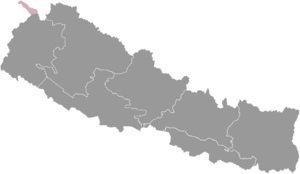Nepal
| Federal Democratic Republic of Nepal सङ्घीय लोकतान्त्रिक गणतन्त्र नेपाल | |
|---|---|
Map of Nepal
| |

|

|
| Flag | State Emblem |
Nepal, officially the Federal Democratic Republic of Nepal and from 1768 to 2008 the Kingdom of Nepal, is a capitalist country in South Asia bordering India and China. It lost some territory to the British Empire in the early 19th century though was never fully conquered, nor was it ever colonized. It did, however, form an alliance with the British Empire and serve as a buffer state against the Qing empire.
Monarchy
Nepal had been feudal monarchy for 240 years. During that time the country had an institutionalized caste system, expanded into the Panchayat system in 1961 by the king, which introduced a police state, formally institutionalized the monarchy into the national identity, and established a hierarchical form of Hinduism as the state religion. Peasants continued to live on agricultural communes into the late twentieth century. The Kingdom of Nepal had remained an impoverished peasant economy for the entirety of its existence.[1]
Jana Andolan
The 1990 "Jana Andolan", or "People's Movement", was a movement that was first expressed as a series of protests led by students and leftists, which culminated in the first nationwide uprising against the monarchy. The movement was driven by the total lack of societal progress and sought the abolition of feudalism in Nepal. General strikes reached into the cities from the villages. In response to the unrest, police began attacking protesters, sometimes firing at random into peaceful demonstrations.[2] Suppression of opposition members was also common, and police kidnapped and tortured many demonstrators.[3][4]
Civil war and communist rise to power
The country had a civil war from 1996 to 2006 between Maoists and the government, with the Maoists seeking to overthrow the monarchy and establish a people's republic. The Maoists fought alone, while the Kingdom of Nepal had support from the United States, the United Kingdom,[5] Belgium,[6] India,[7] Pakistan, and the People's Republic of China,[8][9] receiving thousands of rounds of ammunition, rifles, grenades, several helicopters, and training, though the United Kingdom and India suspended their material support after the king seized power in 2005 and declared a state of emergency.[10] The civil war resulted in the abolition of the 240-year-old monarchy and the entry of Maoists into mainstream politics, who emerged as the third-largest party and committed themselves to multiparty democracy and to developing the economy first, rather than focusing on introducing socialism. Nepal's constitution of 2015, which is the current one, defines the country as "an independent, indivisible, sovereign, secular, inclusive democratic, socialism-oriented federal democratic republican state" and that the intention is to establish the foundations for a socialist economy. Before the 2017 general and provincial elections, and having already won the most seats in local elections that year, the Communist Party of Nepal (Unified Marxist–Leninist) formed an alliance with the Communist Party of Nepal (Maoist Centre) and became the largest party in the House of Representatives, as well as in six of Nepal's seven provinces. On February 6, 2018, the CPN (UML) emerged as the largest party in the National Assembly elections (the National Assembly is the upper house of the bicameral Federal Parliament of Nepal, with the House of Representatives being the lower house). Party chairman Khadga Prasad Oli was subsequently appointed prime minister on February 15, followed by Bidya Devi Bhandari, also of the CPN (UML), being re-elected president on March 13 (having first been elected in 2015). The CPN (UML) and CPN (Maoist Centre) merged on May 17, 2018, forming the Nepal Communist Party. Communists, however, still have no formal vanguard role in the constitution, so Nepal is not a "communist state" despite being socialist-leaning.
References
- ↑ Poverty Profile Executive Summary: Kingdom of Nepal, Japan Bank for International Cooperation
- ↑ https://web.archive.org/web/20210128095235/https://www.latimes.com/archives/la-xpm-1990-04-07-mn-634-story.html
- ↑ https://web.archive.org/web/20210128093919/https://apnews.com/article/c3f448049aa795987f888e210698fb8a
- ↑ https://www.refworld.org/docid/467fca351e.html
- ↑ Nepal's Maoist cauldron draws foreign powers closer
- ↑ Une polémique éclate en Belgique sur une vente d'armes au Népal
- ↑ Nepal’s Civil War and Its Economic Costs
- ↑ Nepal gov't procuring military articles from China, Pakistan
- ↑ Chinese 'deliver arms to Nepal'
- ↑ Mahendra Lawoti and Anup K. Pahari, editors (2010). The Maoist Insurgency in Nepal: Revolution in the twenty-first century. Routledge. ISBN 978-0-415-77717-9.
{{cite book}}:|author=has generic name (help)
